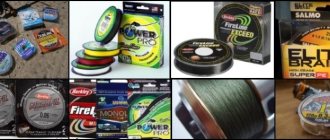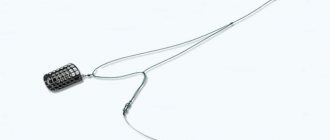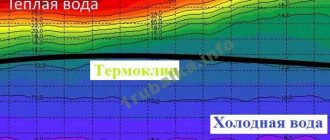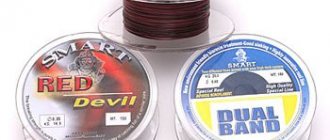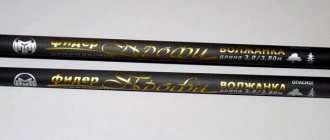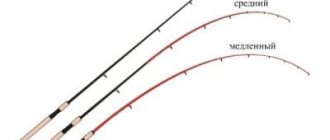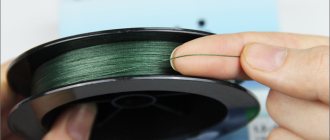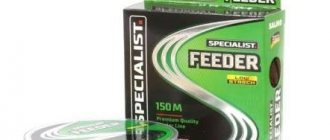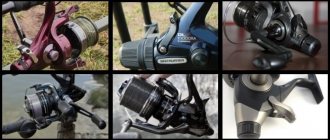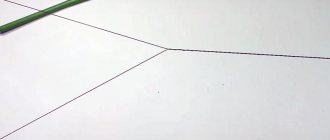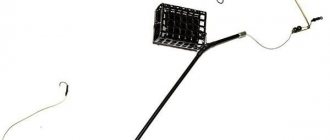Created: 07/13/2020
Updated: 07/17/2020 12:29:34 Share:
*Review of the best according to the editors of expertology.ru. About the selection criteria. This material is subjective in nature, does not constitute advertising and does not serve as a purchase guide. Before purchasing, consultation with a specialist is required.
The most important component of the feeder tackle is the fishing line. The main tasks of this element will be to deliver equipment to a certain distance and successfully land fish. Since any foreign object in the water alarms observant representatives of the ichthyofauna, the feeder line must combine strength, wear resistance and invisibility. In Russian fishing stores there is an abundance of fishing products from different manufacturers. Some of them are designed specifically for feeder fishing, others have universal use. Recommendations from our experts will help novice anglers choose a fishing line with optimal performance properties.
What is better fishing line or braid?
We have already devoted a separate article “Which is better than braided or fishing line,” where we found out the advantages and disadvantages of monofilament and braided fishing line. And we were convinced that both fishing braid and fishing line can be used in certain conditions of fishing on the feeder.
The main advantage of braided wire, which is not so easy to argue with, is its sensitivity . This property especially plays an important role not even when transmitting a bite, which is of course important, but when tapping the bottom to find a suitable fishing spot.
But the feeder line also has its trump cards. The first is the price, which you will agree is not so unimportant. Since you often have to fish with a feeder on the edges, among colonies of shells, cut-off lines are often found. And braided fishing line is just more susceptible to such damage than regular mono. And it’s a shame to lose several meters of braid on the edge.
As for sensitivity, here again you need to look at what distances you are fishing at. With a casting distance of about 20-30 meters, there is no noticeable difference in sensitivity whether we use braided or monofilament.
Well, last but not least the difference. This is the presence of stretchability in the fishing line. It is this that gives the feeder more chances when landing large fish. This stretchability absorbs the jerks of the fish, and can sometimes play a decisive role in the fight against trophy fish. The use of monofilament is especially justified on paid carp reservoirs. In such conditions, the fish bite will be very noticeable and the process of fishing itself comes first.
Types of fishing line used
Currently, two types of fishing lines are used for feeder fishing: monofilament or braided. The latter is a cord knitted from several threads. Each type of fishing line has its own advantages and disadvantages. The use of a particular species may be determined by fishing conditions, type of prey, or personal preferences of the fisherman. Often, only having your own experience helps you make the right choice of the type of fishing line used.
Monofilament fishing line or monofilament is a regular nylon thread. This kind of gear appeared in feeder fishing earlier than anyone else and, despite the appearance of braids, remains popular with most anglers. This is explained by the following positive properties of monofilament:
- low price;
- rapid immersion in water (for lines with negative buoyancy);
- softening jerks when catching large prey (carp, carp, bream, etc.);
- low visibility in water.
However, along with its advantages, monofilament also has some disadvantages. The main ones are low breaking load and low sensitivity of bites. In addition, monofilament has the following negative qualities:
- it is susceptible to drying out and exposure to ultraviolet radiation;
- does not tolerate high temperature and its sudden changes;
- low durability - the monofilament line has to be changed every season;
- strength at bends or nodes is significantly reduced.
Visual differences between different types of fishing line.
For a braided cord, which is a multi-strand thread, the picture is a little different. It consists of a large number of thin fibers from various polymers, which are intertwined and held together with a special composition.
The manufacturing technology leaves its mark on the cost of the product, but at the same time it is possible to get rid of some undesirable aspects inherent in monofilament.
The advantages of braided wire include:
- higher breaking load compared to multifilament, which allows the use of a thinner cord (the thinner and lighter the cord, the faster it will come off the reel - the casting process is significantly easier and the tackle flies a greater distance);
- longer operating time;
- absence of longitudinal deformation (the cord does not stretch), which leads to increased sensitivity;
- has a low “torsional memory”, that is, after using the load it practically does not deform.
However, such improvements came at the cost of some inconveniences:
- braid is significantly more expensive than monofilament;
- she drowns worse;
- better visible in the water column;
- has the ability to attach various small debris to itself;
- due to high strength and lack of deformation, it does not soften sharp jerks of large prey;
- braided rod requires a more durable feeder rod, or at least its guide rings, since it can quickly wipe not only them, but also the line roller.
As you can see, existing feeder lines have different properties. Some of them even seem mutually exclusive. Therefore, the question of how to choose a fishing line for a feeder is very relevant. It is relatively difficult to take into account all possible scenarios when fishing. Below are the criteria for choosing a fishing line for feeder fishing depending on various conditions.
What diameter of fishing line should I put on the feeder?
To determine the diameter, we must first decide what kind of fish we are targeting. Accordingly, what breaking load do we need? Let us remind you that the breaking load indicated on the reel tells us what maximum load the dry fishing line will withstand without knots.
On our website there is a whole article “knots for fishing”, where we have determined which fishing knots are the strongest and have the least impact on the maximum breaking value. And they found out that the best knot reduces strength by at least 10%. Let's add here that a wet fishing line loses its strength by another 30%. Plus wear and tear, exposure to the sun...
When fishing on a feeder, you often have to throw feeders and 80 and 120 grams filled with bait, and this places increased demands on strength.
On the other hand, a larger diameter of the fishing line creates greater windage when fishing in the current. Which forces the use of heavier feeders.
I would not recommend using a main feeder line diameter below 0.18. On diameters of 0.18-0.24 mm, to avoid shooting the feeder when casting, you can use a shock leader for the feeder, which we discussed in detail in a previous article on our website.
As we know, rings of small diameters are used on feeder tips. If you use a shock leader when fishing on a feeder, then you need to learn how to tie line to line with the correct knot. The knot should pass through the feeder rings as freely as possible and have the least impact on the casting range of the feeder feeder.
Often the breaking load is indicated in pounds ( lb is approximately 0.45 kg ).
You can roughly calculate the required strength as follows: for every 10 grams. For feeders we take 1lb fishing line strength . And we get that for a Light feeder 6 lb , and for an Extra Heavy feeder 15 lb .
But it must be remembered that on the reel with fishing line one value of the breaking load is indicated, but in practice it is always less. Due to the fact that any monofilament wears out quite quickly, after each fishing it is necessary to cut off the first few meters of it. Here are the most common values for the ratios of pounds and kilograms:
Fishing line and braided cord - an eternal confrontation
For some reason, feeder fishing is associated with the use of braided line, especially in our country. At the same time, traditionally the feeder initially used monofilament as a fishing method. Feeder line is common in England, the birthplace of this fishing method.
Of course, both fishing line and braided cord have advantages and disadvantages.
- It's cheaper than the cord.
- It is less demanding on the quality of the coil, because the loops dropped from it can be untangled. With a cord - no.
- A good one has a maximum elongation of approximately 5%. The line is about 1%, so it shows bites better at long distances.
- In still water there is not much difference between line and line, just as in weak currents.
- Lasts longer than any cord.
- When fishing with a feeder, you can use a not very expensive cord, which in cost will not be too different from the fishing line.
- Less often it overlaps the tulip. This is critical for novice anglers who are not used to checking the overlap before casting.
- Absorbs jerks of fish, as well as too sharp casting and jerking at the end of casting when you forgot to lift the rod. Cord - no.
- The cord is indispensable for long-distance casting, as it has less thickness and specific weight.
- The cord is ideal for fishing in strong currents, where any fishing line will cause the feeder to be carried away, making it impossible to catch.
- The braided cord gives greater sensitivity to the gear during capricious bites, as it allows you to register even weak bites.
- Hooking with a line can be smoother and more precise. At a long distance, the fish is better positioned with it, since the fishing line has to overcome not only its stretchability, but also the resistance of the arc of a thicker fishing line in the water.
- When pulling out the fishing line, it does not affect the angler’s tactile sensations in any way, but the cord can tug the hand unpleasantly. Those for whom fishing is a vacation from which they need to get maximum positive emotions will prefer fishing line to cord. This does not affect the fish bite in any way.
- High-quality probing of the bottom using a marker weight is only possible with a cord, since it clearly transfers into the fisherman’s hand all the features of the bottom along which the weight is dragged.
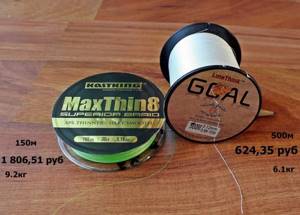
Convert lb to kg
| Test lb/kg | Test lb/kg | Test lb/kg | Test lb/kg | Test lb/kg |
| 2lb / 0.907kg | 7lb / 3.18kg | 16lb / 7.26kg | 25lb / 11.34kg | 55lb / 24.95kg |
| 3lb / 1.36kg | 7lb / 3.18kg | 17lb / 7.71kg | 26lb / 11.79kg | 60lb / 27.22kg |
| 3.5lb / 1.59kg | 8lb / 3.63kg | 18lb / 8.16kg | 30lb / 13.61kg | 65lb / 29.48kg |
| 4lb / 1.81kg | 10lb / 4.54kg | 19lb / 8.62kg | 32lb / 14.52kg | 66lb / 29.94kg |
| 4.5lb / 2.04kg | 11lb / 4.99kg | 20lb / 9.07kg | 33lb / 14.97kg | 80lb / 36.29kg |
| 5lb / 2.27kg | 12lb / 5.44kg | 21lb / 9.53kg | 37lb / 16.78kg | 100lb / 45.36 |
| 5.5lb / 2.49kg | 13lb / 5.90kg | 22lb / 9.98kg | 40lb / 18.14kg | |
| 6lb / 2.72kg | 15lb / 6.80kg | 24lb / 10.89kg | 50lb / 22.68kg |
The best fishing line for a feeder
What is the difference between a feeder line and a regular line? First of all, this is its rigidity; it should have significantly less elongation than regular monofilament.
So, the site “Feeder Fishing” presents a review of, in our opinion, the best monofilament lines for feeders from ten manufacturers. In this review, we will look at the advantages and disadvantages of feeder and universal lines with reduced elongation, suitable for feeder fishing.
I draw your attention to the fact that the conclusions presented are the subjective opinion of the authors of the site feederist.ru. We do not claim to be the final authority in this matter. This is just our experience and the experience of fellow fishermen in using feeder lines. As you will see below, in most cases there are more disadvantages listed than advantages. This is because when testing something, they first of all talk about shortcomings. The fewer there are, the closer the quality of the product is to the required parameters. And monofilament’s compliance with our standard requirements cannot be its advantage.
For example, compliance of the practical diameter with the declared one (zero difference or less than 0.05, with a diameter greater than 0.2) cannot be an advantage. But the discrepancy between the diameters is already a disadvantage.
Well, enough theory, let's get down to analysis:
Unwinding and winding
Feeder lines have one unpleasant property. Their low elongation works within the limits of elasticity. If they have to experience stress in the breaking area, they begin to stretch. You can feel this with your hand when you release the feeder from the hook, for example. After this, the fishing line loses its properties, and it would be better to immediately cut off a piece right up to the feeder and bandage the installation.
Therefore, when winding, it is necessary to have a significant reserve on the reel, since you will have to tear it off often and a lot. Usually this is about 200 meters, the coil may not allow more. The fishing line has fewer requirements for the latter than the cord. It has to be wound exactly under the side to avoid loops. In order to avoid loops on the monofilament, on the contrary, it needs to be slightly underwound. Moreover, the stiffer the line, the more under-reeling you need to do. A cheap fishing line that has a greater memory effect - more than an expensive one without it.
It won’t be critical if there are three or four millimeters left to the edge of the spool. Of course, this will affect the casting distance. However, it’s one thing when this is done on a spinning rod, which is used to throw weights weighing up to five grams - there it is significant. When casting a feeder weighing 20-40 grams, the fact that the lines are underwound more than is recommended for a spinning rod will not affect the distance so much, and it will still be possible to cast to where required. By the way, the rigid feeder main line untangles just fine, and you can forget about losses as a result of beards from the reel.
It is worth noting that for fishing with a fishing line you can use an inexpensive reel or an inexpensive rod, even with bad rings. The monofilament makes excellent friends with the plastic spool that most cheap reels are equipped with. Also, it is not too demanding on the inserts on the rings and will not immediately become unusable if a notch appears on one of them, like a braided line. However, you should not buy the cheapest gear - they have a lot of other disadvantages, with which even using a fishing line instead of a cord makes fishing very uncomfortable and ineffective.
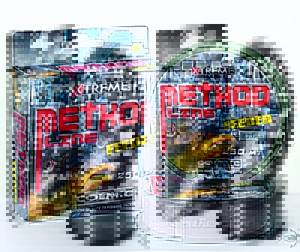
Feeder lines from Shimano
Our review opens with such a well-known brand of fishing tackle as Shimano. Despite the high prices, the gear from this company is widely popular among fishing enthusiasts.
This manufacturer offers us Shimano Technium . Its elongation is only about 12%. According to the application and supposedly it occupies an intermediate position between “monofilament and braided cord”.
It is difficult to imagine such a situation, but as practice shows, the rigidity of this line is quite suitable for feeder fishing. Presented by Shimano Technium in windings of 200 and 300 meters.
If the price suits you, then you can safely opt for the Technium series. It will last 3-4 years and is perfect for a feeder.
There is also a camouflage mono from this Shimano Technium Tribal
Advantages of Shimano Technium:
- real low stretchability;
- high rigidity;
- real durability, practically higher than that of fishing lines from other manufacturers;
- the diameter corresponds to the declared one;
Flaws:
- high price. The price is approximately 3-5 times higher than similar fishing lines from other manufacturers. For this money it is quite possible to buy an inexpensive cord;
- a large number of low-quality fakes. You need to buy it in trusted branded stores;
- In our opinion, a fishing line with a diameter of less than 0.2 has a high memory for twisting. When weakened, for example when filling the feeder, the line may twist behind the rings of the feeder tip.
Groundbait and lures
Carp is constantly hungry, so you don’t have to be afraid to feed it. To catch carp on a feeder, about 4 kilograms of bait are used. It is allowed to make combinations of both plant and animal components. After all, he is an omnivore.
To achieve excellent results, you need to balance the bait:
- The basis;
- Large faction;
- Bait;
- Flavoring.
Homemade porridge or a purchased mixture is used as a base. Half of the volume consists of it.
Before you start fishing on the feeder, you need to take care of pre-baiting the “table”. As you know, this is necessary in order to attract carp, but not to saturate it, but to interest it and push it to grab the bait.
As you know, the carp family is large omnivorous representatives that absorb food a lot and quickly. Therefore, you will have to take a lot of complementary food with you when fishing, from 2 to 5 kg. What is the best way to catch carp, you ask?
If you manage to scout a pond, try experimenting with 3-5 different attachments and baits. If fishing is carried out in a little-known place, it is better to use at least 10 different options.
The omnivorous nature of carp gives a greater opportunity to choose effective bait. The main thing is to use both animal and plant ingredients.
Bait of plant origin includes:
- Corn.
- Pearl barley.
- Dough.
- Peas.
You can also expand the range with numerous boilies. This is the name of special flavored balls for carp fishing.
The choice of bait mixture depends entirely on the fishing method. If fishing is carried out using a simple feeder method, then the mechanical composition of the bait should be appropriate: loose, easily washed away by water. Any basic commercial mixtures for carp fish are excellent. You can also use popular recipes for dry mixtures from experienced fishermen.
When fishing with pre-feeding, the consistency of the bait can be made thinner, with a viscosity closer to porridge. For this fishing method, you can use the “Salapin” cooking recipe.
When fishing with method-type feeders, the consistency of the bait is the densest, because during such fishing, the carp absorbs the bait like candy.
In feeder carp fishing, both traditional “folk” baits and newfangled ones that come from carp fishing are used. Depending on the time of year and other conditions, carp can be caught with the following baits:
- bunch of worms;
- a bunch or boilie of maggots;
- dough boilies;
- pellets;
- peas;
- corn;
- dough;
- bread;
- mastyrka;
- hominy;
- boiled potatoes;
- steamed cereal grains;
- barley;
- pasta.
Feeder lines from Trabucco
Trabucco , in our opinion, is one of the most popular monofilament and cord manufacturers among anglers. A wide range of products offered and a low price are the main trump cards of this brand.
Three series of lines from Trabucco are mainly used as feeder lines. This is primarily the Trabucco T-Force feeder . And two universal series that are quite suitable for a feeder are Trabucco Force Sinking and Trabucco T-FORCE Competition Pro .
Advantages of feeder line from Trabucco
- low price;
- good rigidity and low elongation;
- “conditionally good” durability and abrasion protection. (There is no clear opinion on this matter. The merit can be considered conditional. It depends on both the chosen series and the party.)
Flaws:
- high memory;
- the disease of all lines from trabucco is an underestimated diameter. (Most monofilament lines larger than 0.14 have a reduced diameter indicated on the packaging, which may be less than practical by 0.05-0.2 mm);
- “conditionally poor” durability and abrasion protection.
Fishing lines from Suffix
The American company Suffix is known to feeder fishing enthusiasts primarily for its inexpensive and high-quality braided cords. But in the series of feeder monofilaments from Sufix you can also choose several good options.
A series of monofilament lines for a burgundy-colored feeder Sufix feeder mono , the elongation of which, according to the manufacturer, is close to zero. Sufix Specialist Carp also performed well .
Advantages of fishing line from Suffix
- low price;
- good wear resistance;
- Sufix Specialist Carp series has low stretch.
Flaws:
- some indicated diameters do not coincide with the real ones, both larger and smaller;
- The feeder monofilament line of the Sufix feeder mono series is quite soft and not rigid enough for feeder fishing.
Fluorocarbon
Some people recommend using fluorocarbon for leaders or main line. Well, it has a low memory effect and is quite rigid. It is absolutely invisible in water, since it has the same refractive index of light. However, the tensile strength of the fluoric for the same diameter will be lower than that of a good nylon-based monofilament line. Therefore, for the same conditions, you will have to use a thicker vein with all the ensuing consequences when fishing in the current and at a distance. The transparency of fluoric does not save it from good light conductivity. On the contrary, the light spreads even better along its length, and the author has not yet seen colored fluorescent light on sale.
This is also not the best material for leashes. It is hard, holds knots worse, and thin ones are hard to find on sale. Therefore, it is definitely worth abandoning it during normal fishing and using it only in very specific conditions, when you absolutely cannot do without it.
Feeder lines from Owner
Owner is, first of all, high-quality hooks - every angler knows this. But you can also find good monofilament feeder from this manufacturer on the fishing line market. These are not special feeder lines, but more universal ones, but they are also well used for feeder fishing. These are such series as: Owner Broad and Owner Broad Carp . Sold in coils of 100-300 meters.
Advantages of fishing line from Owner:
- real low line memory;
- average price;
- good camouflage color;
- good wear resistance.
Flaws:
- very soft line, more suitable for leashes;
- high stretchability, it is better to fish at distances up to a maximum of 20-25 meters.
How to choose a fishing line for a feeder in a store
It may happen that when you come to the store, you do not find the above fishing lines, and you will again be faced with the task of which fishing line for the feeder can suit me. Here you will have to rely on the knowledge you have acquired and get your head around it, because you can determine all the advantages and disadvantages of a fishing line only after fishing on it for at least a season. But we will now look at how to avoid taking an outright fake and 100% unnecessary rubbish from a store.
Firstly, there are many fakes on sale that look like well-known brands, for example the original Owner , and the fake O vner or FiriLine instead of FireLine, they simply changed the letter. Many people get caught in this because they are careless. Also a sign of a fake is an unevenly glued label, the absence of a barcode, a fishing line spool that has jagged edges or edges that have been sanded in an artisanal way. The box itself can also tell a lot, falling apart thin cardboard with washed out colors are all signs that the feeder fishing line is a fake, because a fake should have as little cost as possible.
Checking the quality of monofilament fishing line
A good monk should have a glossy finish, which means that the line has not had time to lie, but the presence of a matte color is a sign that it has been lying around for a long time. Also pay attention to the memory of the fishing line. To do this, pinch it with two fingers so that when you start to pull, you feel the tension. As a result, you should have an even and smooth line at the output. A good fishing line should have the same diameter in all areas, unfortunately, you need a micrometer to check this.
Braided cord
Often, when winding, the manufacturer leaves the tip of the fishing line accessible; take it and touch it with your fingernail to see if the braid is shaggy or not. Unwind a little and test for rigidity. Also make sure that there are no frayed or uneven areas on the cord or places with uneven color. The braid should be as round as possible and in no case flattened, otherwise it will often get tangled and float more. It is worth noting that now many branded manufacturers have young ones breathing down their necks, so often cheaper braids are not inferior in quality to such dinosaurs as Power Pro or FireLine . When you go to the store, you can buy several pieces of inexpensive fishing line and use them as a shock leader. Having caught several fishing trips with it in places where the ground is covered with shell and sharp stones, you will be able to evaluate its strength, rigidity, resistance to defects, availability of memory, and if everything suits you, then buy several skeins of such fishing line.
Feeder lines from Gamakatsu
Another manufacturer of high-quality hooks offers us their fishing line. Just as the Owner and Gamakatsu hooks “go side by side”, the lines they offer are very similar. And the price for them is approximately the same. Like its main competitor in fish hooks, Gamakatsu does not have a special feeder line. But for our feeder fishing, Super G-Line .
Advantages:
- low memory for twisting;
- good wear resistance;
- average price;
Flaws:
- high elongation. Suitable for short-range fishing only.
Feeder lines from Colmic
Colmic are popular among anglers . Let's see which series may be suitable for feeder fishing. One of the most popular is the Race Sinking Lane . Its use for feeder fishing is not justified. This series has stretchability that is unacceptable to us.
For feeder fishing, we can highlight such new series as Colmic Lurs Cosmo , Colmic Lurs Camouflage and Colmic Fendreel K15 . The first has a greenish tint, and the second is multi-colored. The color on Lurs Camouflage changes approximately every 30 cm. Colmic Fendreel K15 has a fluorescent effect and has a bright blue color, which is not familiar to many.
Advantages:
- good abrasion resistance;
- low memory;
- Colmic Lurs Cosmo and Colmic Lurs Camouflage are wound on spools using anti-torsion technology, which prevents twisting after rewinding onto the spool;
- average price;
Flaws:
- insufficient rigidity for feeder fishing. It should only be used at close distances.
Conclusion
Line is an excellent material for pickerel fishing, for fishing at short distances. In half the cases when fishing with a feeder in our conditions, it can and should be used instead of a cord. It's perfect for beginners. It is worth choosing a rigid fishing line that has low elongation and is specially designed for feeder fishing. Leashes should also be made from monofilament. Fluorocarbon is not used in feeder fishing or is used very limitedly.
You can ask your question to our author:
Feeder lines from Balsax
Many people know inexpensive monofilament lines from Balsax . You can buy them everywhere and their range is very large. Two series can be used as a feeder line: Balsax Iguana and a special feeder line with less elongation American Fish . A pleasant low price cannot but please fishermen. But it makes sense to use it as a basis for a feeder only at short casting distances or when mastering feeder fishing skills.
Advantages:
- low price.
Flaws:
- soft and highly stretchable.
Fishing lines from Salmo
The Baltic company Salmo offers a special monofilament line Salmo Professional feeder . It comes in eight different diameters from 0.2 to 0.4. It has a two-tone color of dark red and black. The colors alternate after about 40 cm. Moreover, if you check the tensile strength, the breakage occurs mainly in the red section of the fishing line.
Advantages:
- low memory;
- low price;
Flaws:
- high stretchability. At fishing distances of more than 30 meters, every second bite is practically unnoticeable;
- the indicated diameter of the fishing line is less than practical.
Top 5 best monofilament lines for feeder fishing
Despite the fact that the vast majority of fishermen associate feeder fishing with the use of braided cords, they are in no hurry to give up monofilament. In a number of situations, it is the monofilament (or a shock leader from it) that is able to show the best results, but only when the fishing line is selected correctly and its characteristics correspond to the fishing conditions. It is for this reason that the idea came up to compile this top, talking about those fishing lines that impressed me.
Under what conditions will monofilament outperform braided cord?
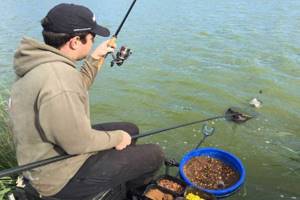
- Short fishing, at distances up to 25-30 meters. The main advantage of braid is non-stretchability and, as a result, high sensitivity, the less noticeable the smaller the fishing distance;
- Fishing on stones, shells and other cluttered bottom. In such a situation, a braided line fails very quickly, and therefore the angler is forced to use either monofilament or knit a shock leader from it;
- Fishing for carp and grass carp in commercial waters. Fishing for a large and strong trophy on a braided line is an emotional task, but it is fraught with numerous slips, breaks and, in some cases, even breakage of the rod;
Well, of course, one should not write off cases when an angler purposefully fishes with monofilament in any situation, preferring it to braided line due to his personal convictions.
The best feeder lines for 2021. Which one to choose?
COLMIC METHOD FEEDER
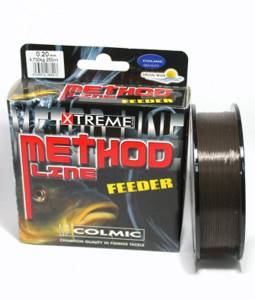
Colmic fishing lines are rightfully considered one of the best, regardless of type and purpose, and METHOD FEEDER is a bright representative of them. Despite the methodological focus, this fishing line is also suitable for a classic feeder.
Among the main advantages are minimal elongation (about 10%), as well as the correspondence of the actual diameter to what the manufacturer claims. It is also worth noting the high abrasive resistance, which allows you to fish on shells without fear of cutting edges and damage to the installation. The high tensile strength should also be noted - a fishing line with a diameter of 0.2 millimeters can withstand almost 5 kilograms of load.
For a classic feeder, you can take a closer look at models with a diameter from 0.18 to 0.28 millimeters. The approximate price tag is $6.5 for a 250-meter unwinding.
Browning Feeda Line Cenex
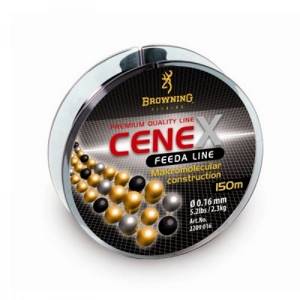
Another European manufacturer whose products deserve some attention. Cenex is a fishing line that almost every floater and feeder knows about; this model is considered one of the best fishing lines in principle, and Feeda Line Cenex is its ideological successor in the monofilament class for use as the main one.
The declared elongation is at the level of 12%, which is quite good both in terms of sensitivity to bites and in terms of shock-absorbing properties. The breaking load is quite good: for example, a model with a diameter of 0.18 millimeters can withstand about three kilograms of dynamic load.
As a feeder line, it is best to look at models with diameters from 0.2 to 0.27 millimeters in a 150-meter unwind. The cost is about 4.5 dollars.
Sensas Feeder Tech Competition
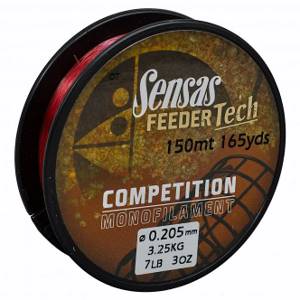
Who said that the French company Sensas produces bait exclusively? The manufacturer's catalog contains a great variety of fishing gear and accessories, from marker weights to platforms and fishing rods.
There is also a range of high-quality feeder lines - Sensas Feeder Tech Competition is a prime example of this. The line holds the knot perfectly and practically does not “plus”, it is not afraid of ultraviolet radiation and perfectly withstands mechanical loads, allowing the angler to be confident when fishing on a hard and cluttered bottom.
This model cannot boast of excessive strength - a fishing line with a diameter of 0.205 millimeters can withstand a little more than 3 kilograms, but for a classic feeder this is more than enough. Models with a diameter from 0.25 to 0.28 millimeters, produced in unwinding lengths of 150 meters, are suitable for the feeder. The fishing line cannot be called cheap - about 11 dollars in equivalent.
Salmo Specialist Feeder mono
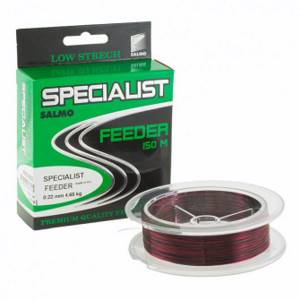
An inexpensive model from Salmo, definitely worthy of attention from feeders. The correspondence of the real diameter is successfully combined with a fairly high breaking load - a model with a diameter of 0.2 millimeters can withstand almost four kilograms of dynamic load.
Visual control is facilitated by the contrasting black and red color scheme, clearly visible in any situation. The stretchability of the model is at an average level for feeder lines (about 13%).
For a classic feeder, models with a diameter from 0.16 to 0.28 millimeters, produced in unwinding lengths of 150 meters, are suitable. A nice feature of this fishing line is the price tag – about 3 dollars.
Colmic Feeder Pro
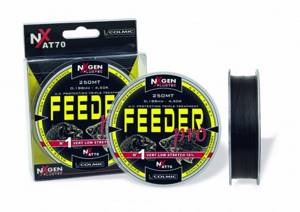
Another model from Colmic that I couldn’t pass up. The main difference of this fishing line is the maximum elongation among the entire top - about 16%, which has a positive effect on the shock-absorbing characteristics of the fishing line and allows you to work with thin leashes without resorting to the use of a friction clutch. Trophy hunters will appreciate it!
In addition, the fishing line is highly resistant to tearing (a model with a diameter of 0.188 millimeters can withstand 4.5 kilograms of dynamic load) and holds the knot perfectly, with virtually no loss of strength on it. The line is not afraid of mechanical stress and is perfect for fishing in conditions of a hard bottom, stones and shells.
The model is available in 250-meter unwinding, the estimated cost is $9.
Mono lines from Maver
Maver company does not have a special feeder line in its range. But he recommends fishing lines such as: Maver SLR and Dual Band . When manufacturing Maver Dual Band, a connection of two monofilaments with different characteristics is used.
The softer SLR line is suitable for leashes. There is also a good series Maver Red Devil . In terms of stretchability, it is inferior to Dual Band , but is also suitable for fishing up to 25 meters.
Advantages:
- the SLR and Dual Band series have very low stretch;
- high wear resistance and resistance to shells;
- very low memory;
